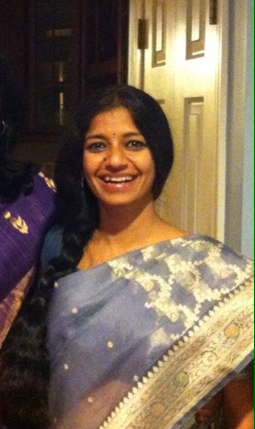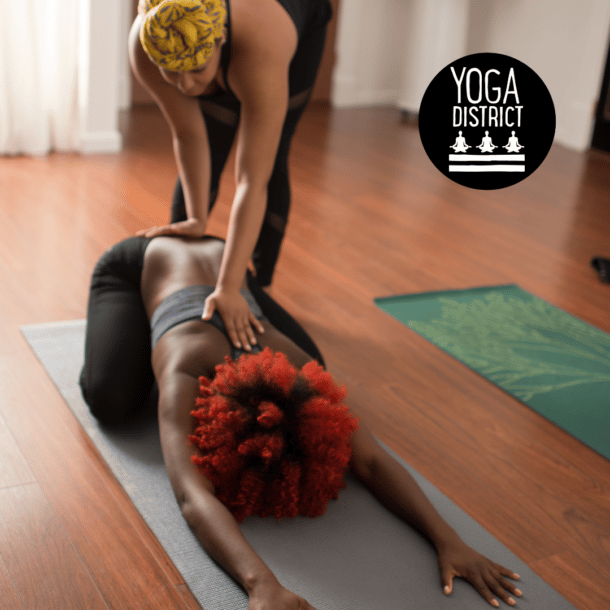 Today’s Teacher Feature introduces you to an intelligent and ambitious, yet very humble, member of the Yoga District (YD) team of instructors: Smita. In addition to teaching at YD, Smita does research related to women’s empowerment at George Washington University (GWU) and is in the midst of a 500-hour yoga teacher training program with Sri Dharma Mitra. Read our full Q&A with her to learn about her appreciation for sharing yoga with others, and how teaching helps her build her own practice.
Today’s Teacher Feature introduces you to an intelligent and ambitious, yet very humble, member of the Yoga District (YD) team of instructors: Smita. In addition to teaching at YD, Smita does research related to women’s empowerment at George Washington University (GWU) and is in the midst of a 500-hour yoga teacher training program with Sri Dharma Mitra. Read our full Q&A with her to learn about her appreciation for sharing yoga with others, and how teaching helps her build her own practice.
What is your favorite style of class to teach, and why?
Dharma! Over the last fourteen years, I have practiced many different styles of yoga, but three years ago I found the Dharma style and its simplicity appealed to me. It is a classical form of yoga, with little or no words but mainly silence. It helps me to become quiet. My favorite practice is at home, with no words, no music . . . just silence.
Describe your personal circumstances or experiences that made you want to share yoga.
Teaching yoga was not my plan and the idea of teaching a yoga class was scary. For a long time, I hesitated taking the yoga teacher training. However, sometime during the teacher training it clicked — I didn’t have to be a guru or an enlightened one to teach yoga: I was just sharing my practice. Since then, it has just been sharing, and then a more significant realization took place: sharing actually helps me practice. So, when I don’t practice, I don’t feel authentic in my class. So the classes help me in my practice.
What advice do you have to others sharing or seeking to share yoga with others?
We all have our own unique experience, so just try and be yourself as your share your practice!
Please describe a challenging moment that you have experienced teaching, how you faced that challenge, and what you learned from it.
My biggest challenge was to teach a community class. I was scared to teach a community class as I didn’t want to cause any injury. I was focusing on their vulnerability. I attended yoga classes for beginners, attended a training with the street yoga group, spoke to others who had taught similar classes, etc. However, when I started teaching an elderly group (with no or limited yoga background), I realized they were not vulnerable; I was! They were not scared; I was! And slowly, I started facing my fears and in months they were doing poses that I couldn’t have imagined. They helped me deal with my fears. My biggest lesson was to teach and share from my/their strength and resiliency, not our vulnerability.
What pose or practice do you like to teach to help students feel empowered? To relieve stress? Please describe how you saw this practice work with an individual or group.
Based on the group we are teaching, we need to figure out what poses or sequence will work as a good starting point. For example, with the elderly group I started with Dharma gentle and in 4–5 months I was doing Dharma 1–2 with them. In a regular class, I start with Dharma 1–2 and then work my way through it. Sometimes, during a class I stop and make the students watch me do a pose; it could just be a cobra or a sun salutation sequence. It is important to remember that in the beginning students should know/see how to do a pose. Hence, it is important to follow the instructions while doing the poses. It will prevent injury and, later, students can find their own way.
Describe a yoga posture, breath or meditation practice for which your students taught you a practical application.
One of the students from the community group came to me and said, “Thank you for teaching me the fetal position. I do it every morning when I get off the bed. It helps me feel safe and secure.”
Please describe a yoga posture, breath or meditation practice that any of your students connect with and why. Have they taught you a practical application for this or any other pose?
One example is from the Yoga Nidra classes. I had a regular student. Most often he would fall asleep in the first five minutes of the class. After 3–4 weeks, he came to me and said, “Thank you for your classes. You are helping me sleep as I suffer from insomnia.”
How has sharing yoga affected you?
It has and continues to change my life and me. Like I shared earlier, it is helping me practice, it is helping me do day-to-day things in my life, it is helping me be compassionate with myself and others, it is helping me live my life, and it is helping me just be.
Could you describe any best practices in sharing yoga that you apply regularly in your classes?
One thing that I experienced in my first teaching session has stayed with me: it is how to just be myself and how can I can teach from the space of my authentic self. We are the instruments and teaching is only passing through us. Being authentic will make the experience so much joyful. There are days that I may be low on energy and there are days when I am joyful. So how can I let that come through me? The beauty is after the class: I am transformed, feeling a sense of calm and peace every single time.
What is your favorite thing to do around town?
I have many favorite things to do around town, like walk, bike, be still in a park, or simply go to a yoga class.
What is your favorite thing about the DC yoga community?
The openness to experience yoga and its different facets is something unique about this city and its people. People come to the classes for a physical practice and soon you see them in kirtan, satsang or meditation class!
If you had to describe your life in the form of a yoga pose, which pose would it be?
I would say the forearm balance! It has been two years and I am still learning 🙂 I fall every single time, but I try again. It is a mixture of emotions and experiences; the joy of getting up there for a second, frustrations of not getting it, fear of falling, and falling, but the willingness to try it again and again every day.
How long have you been in DC?
Four years ago, I came to DC to pursue a doctoral program at GWU to study how middle-class women who experience domestic violence find empowerment through their work. I came across YD in early 2012 and was an intern for almost two years. I started as an intern not just to get free yoga classes, but also to belong to a community in a new country!
YD is happy to have had Smita develop as a part of our yoga community, serving first as an intern and now as a teacher!

